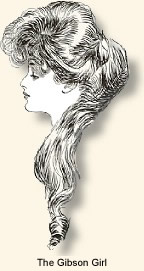|
The Gibson Girl
The pen-and-ink drawings of illustrator Charles Gibson came to represent the spirit of the early  twentieth century in America. His illustrations, appearing in a number of popular magazines, both influenced and reflected attitudes, behaviors and mores in this country. His drawings attracted instant recognition and admiration by the general public. The "Gibson Girl" became a model for fashion mimicked by women and admired by men, while the adventures of "Mr. Pipp" amused his audience and his satirical drawings provided social commentary. His drawings appeared in such popular magazines as Scribner's, Harpers, Collier's, and The Century. His images permeated popular culture, appearing in such non-print items as wallpaper, china plates, matchboxes and umbrella stands in much the same way that today's popular icons grace T-shirts and sweat shirts. twentieth century in America. His illustrations, appearing in a number of popular magazines, both influenced and reflected attitudes, behaviors and mores in this country. His drawings attracted instant recognition and admiration by the general public. The "Gibson Girl" became a model for fashion mimicked by women and admired by men, while the adventures of "Mr. Pipp" amused his audience and his satirical drawings provided social commentary. His drawings appeared in such popular magazines as Scribner's, Harpers, Collier's, and The Century. His images permeated popular culture, appearing in such non-print items as wallpaper, china plates, matchboxes and umbrella stands in much the same way that today's popular icons grace T-shirts and sweat shirts.
The "Gibson Girl" is probably the best remembered of the artist's images. With her hair piled atop her head and a waist so tiny as to defy belief, the Gibson Girl represented a serene self-confidence that could surmount any problem. The envy of all who knew her, the Gibson Girl remained aloof of her surroundings but not to the extent of haughtiness. She was at once remote but yet accessible. The "Gibson Man," equally as handsome and self-assured as the Gibson Girl, provided her perfect partner. The Gibson Girl and the Gibson Man in some ways represent the "Barbie and Ken" dolls of the early 1900s as icons of popular Culture.
The coming of the First World War ended the public's romance with Gibson's images. The collective outlook changed from confident optimism to reserved cynicism - an outlook in which Gibson's perspective seemed out of place. His popularity waned but there is no ignoring his influence on popular culture during the first decades of the twentieth century.
References:
Gillon, Edmund V. Jr., The Gibson Girl and Her America (1969).
How To Cite This Article:
"The Gibson Girl" EyeWitness to History, www.eyewitnesstohistory.com (2001).
|






